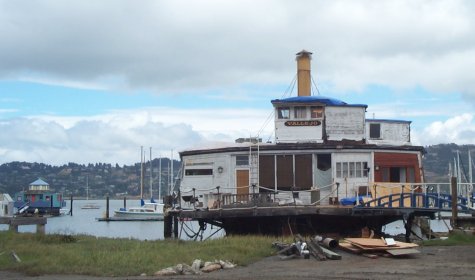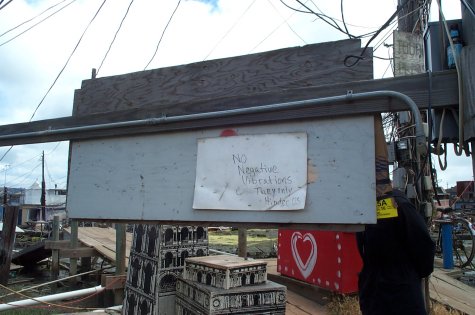Visting
Gate Five Sausalito
With the World's Best Jazz Vocalist

Jackie Ryan welcomes me to her home in the redwoods of Mill Valley
I love visiting really serious artists, people whose outer and inner life are fueled by the urge to create. Jackie Ryan's singing came to my attention long ago--she spent a couple of years on Maui in the 'seventies and still has fans there. In the first conversation I had with Joe Gallivan when we met in September, 1996, he told me he would be recording with a singer he had not met--he had only heard a tape, but he was impressed, and Joe is not easily impressed. The ensuing CD, Surrender, served as an introduction of their trio with pianist Brian Cuomo to Ronnie Scott's Club, Europe's most famous jazz room, where they attracted standing-room-only audiences for a week in April, 1999. On their return in March, 2000, they recorded at Live At Ronnie Scott's album on the club's label during a similarly sold-out two weeks. In a review of the show, John Fordham, author of the authoritative book Jazz, compared Jackie to Betty Carter, who, in his book, he declares was the greatest jazz vocalist of all time. Heady stuff, and entirely deserved, although Jackie is so modest that less talented singers (and that's everyone else, in my opinion) easily push her from the spotlight. Somebody, find this woman a good agent!! You can hear a minute of Surrender on Joe's site at newjazz.com. The Ronnie Scott's CD should be available by next fall.

One must traverse a lovely but dangerous staircase down into the redwood glen to the one-hundred-year old cottage she shares with novelist John Ballard. The two made me very welcome. Everywhere are flowers, interesting art objects, music books, wonderful views of the surrounding forest area. "The saddest thing is that my neighbors cut down the trees for the view," Jackie sighed. "They move here because of the trees, and then they cut them down."

The house clings to a hillside, making
the back porch level with tree tops from the valley.
On the left, behind a tree, stands Mount Tamalpais, which
dominates the landscape of Marin County.

Mount Tamalpais seen from Mill Valley;
a famous local night club named in honor of
the mountain's myth was called The Sleeping Lady.
Jackie and I drove off to Sausalito on a sentimental journey. I had not visited Gate Five Sausalito since the fateful night I brought the newly published Living On The Earth to my mentor, artist Jean Varda in September, 1970. The next morning he boarded a plane for Mexico, where he was murdered. I wanted to see what had become of the houseboats at Gate Five, where I had lived in 1967 and 1968, and the Industrial Center Building, where I had my first art studio during that time. Jackie has some Sausalito memories, too--she was one of the fabulous, wildly dressed hostesses at the Trident Restaurant in its heyday.

Clearly Jean Varda has not been forgotten here; a landing is named in his honor.
Philosopher and composer Stan McDaniel, who lived in a houseboat across the pier from mine, introduced me to Varda soon after I moved to Gate Five, by inviting me on an amazing three day sailing trip on Varda's colorful sailboat. Recently, Stan emailed me three wonderful old photos, one of the boat, and two of Varda with his legions of admirers, who include Anais Nin and Henry Miller. To me, he was the liveliest man I'd ever met, and he was 70 then.

I soon adopted Varda as an artist mentor, and his influence on my art and life is still strong.

I brought him a string of ceramic beads that I had made
and painted.
He put them on and exclaimed, "I am the father of the hippies!"

What we all loved about Varda was his highly imaginative and free-spirited celebration of the simple joys of life.

The Vallejo ferry boat, half of which
was inhabited by Alan Watts and half by Varda
during the 'seventies, seems to have acquired a coat of
white paint since then.

The houseboats remain in their playful and serene funkitude upon Richardson Bay.

Political unity was needed to preserve this stronghold
of creative housing against the
invasion of sanitized upscale marinas. Preserve it as an historic district
or an art treasure, I say.

Lounging in front of the Gates
Cooperative office were Roger Lane (right) and
a buddy, typifying the laid back but muscular men to be
found in the region.
Denizens of these parts must be prepared to deal with
diesel engines and bilge pumps,
sagging catwalks, extremes of tides and weather, travel
by dinghy, and rescuing of sunken hulls.
In the background stands the paddlewheel of the old
Charles Van Damme and a
Gaudi-esque mosaic'd metal sculpture. Not far away stood
the sign below:

"No negative vibrations. They only hinder us." Amen.

My home was moored at the Gate Five
Pier, completely rebuilt since then
and festooned with potted flowering plants. I was happy
to see only improvements.

My hat off to the artist who created this gateway to his or her boat.

From the end of the pier, floating walkways jut. One must be agile to live here.

Mount Tamalpais from Gate Five

The Industrial Center Building not only
still stands, but seems to have received
considerable renovation over the last thirty years--I
remember the building
as painted a light tan that was badly peeling, and it had
no awnings.
The inside of the building looks freshly painted today as
well.

Clearly many artists work here; the
bulletin board blooms with announcements
of upcoming shows of their works.

I found the door to my old studio.

Jackie and I shared a delectable lunch at her old haunt.

She made sure I photographed the
psychedelic ceiling mural, which,
she has been told, the new owner wants to cover with
white paint.

Another monument to the 60's is the architecture and the rich wood with which it was made.

View of San Francisco and the Bay Bridge from our table.
JEAN VARDA:
A Biography by Heide Foley
Jean (Yanko) Varda is best known as a collagist. From 1949 to his death
in
1971, Varda experimented with paper, woven textiles, designer fabrics
and
painting in collage. His color theories and cubist influences are reflected
in the bright, half abstract, half real content of his art. Varda believed
art came from joy. He often made works of women, the still life, exotic
towns with banners flying and the celestial city.
Varda was first taught by his mother, a muralist in Smyra, Greece. Then
he
had several instructors in Alexandria who taught him the great renaissance
masters and realism. In 1913 Varda moved to Paris where the influences
of
Dadaism and Cubism changed his style irrevocably. Switching from chiaroscuro
seascapes, portraits and ship battles to a form of mosaic and scratched
mirrors, Varda explored his Greek roots, the natural brilliance of light
and Byzantium philosophy.
In 1916, he studied at the Ecole de Beaux Art in Paris, shared a studio
with
Braque, met Matisse and Picasso. He traveled to Italy to take notes on
the
works of Raphael, Michelangelo, Giotto, and Fra Angelico. From 1925 to
1939
he showed in Europe, then he moved to the United States.
Varda was successful selling his art in New York, but he preferred to
live
in California. There he befriended Henry Miller and Anais Nin. The collage
work he began during the 7 years he lived in Big Sur was surrealistic,
described as 'dreamscapes'.
In 1949, Varda built a studio in Sausalito with Gordon Onslow-Ford on
the
decommissioned ferryboat, Vallejo. In the early 1960s Ford sold his share
to Dr. Alan Watts, the Englishman who introduced Zen Buddhism to America.
Varda taught at university level, including Black Mountain College, NC;
Pratt Institute, NY; and CSFA, now called the San Francisco Institute
of Art.
Varda has shown at: Neumann Willard Gallery, NY; "Art in Action"
Pavilion
at the Golden Gate International Expose; Walker Art Center, Chicago, IL;
M.H. de Young Memorial Musuem, SF,CA; Brand Library Art Gallery, Glendale,
CA; the Oakland Musuem, CA; and many more.
"There are 3 perfect shapes in the world: a boat's hull, a violin,
and a
woman's body" - Jean Varda
Credit:
Heide Foley, a volunteer at the Sausalito Historical Society, has unearthed
a significant amount of biographical information on Jean Varda and other
Northern Californian artists of the 1930s-1960s. She lives in Sausalito
on the ferryboat Vallejo where Varda lived for 20 years, taught classes
and had his studio. \